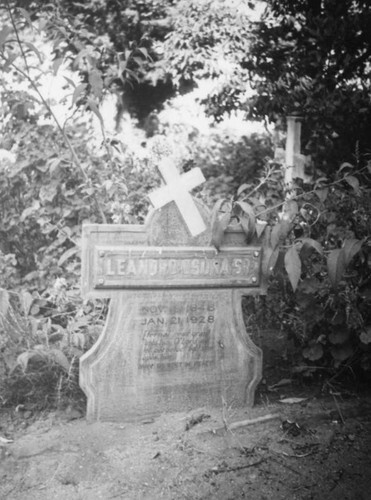Title
Leandro Osuna'S Grave, Mission San Luis Rey Cemetery, Oceanside
Creator
Description
A headstone for Leandro Osuna Sr. reads "Nov. 1848, Jan. 21 1928, Eternal rest grant unto him O' Lord and let perpetual light shine upon him, may he rest in peace." This Leandro Osuna is perhaps the son of the Leandro Osuna who fought for Mexico in the Mexican American war and died shortly after the war was lost, and grandson to Don Juan Mario Osuna, the first mayor of San Diego. Their 15,000-acre Rancho called "Valle de los Viejos" was bought by the railroad and renamed Rancho Santa Fe.
Founded June 12, 1798 by Father Lasuen, then president of the California missions, and administered by Father Peyri, Mission San Luis Rey de Francia is notable for its impressive architecture, a composite of Spanish, Moorish, and Mexican. Between 1798-1832 the mission became home to three thousand Luiseno Indians, who were native to the area. Secularized after Mexican independence in 1821, the land was to be returned to the Indians, however administrators gained title leaving nothing to the Luisenos. From 1847-1857 U.S. soldiers used the mission as a base. In 1850 California became part of the United States, and in 1865 Abraham Lincoln returned the mission to the Catholic Church. It was abandoned until 1892 when a group of Mexican Franciscans came. From 1892-1912, the Franciscans repaired the church and built living quarters on the foundations of the old mission (where the museum is today). Ongoing restoration includes: partial rebuilding of the quadrangle in 1949 for a college that is now a Retreat Center, excavating the soldier's barracks and Indian laundry, and preserving the exterior of the church building in 1984. Art conservation and archaeological research are ongoing. Mission San Luis Rey is located at 4050 Mission Avenue in Oceanside, and was designated California State Historical Landmark #239 in 1936. The 1815 Mission Church was designated National Historic Landmark #70000142 in 1970.
Title supplied by cataloger.; Herman J. Schultheis was born in Aachen, Germany in 1900, and immigrated to the United States in the mid-1920s after obtaining a Ph.D. in mechanical and electrical engineering. He married Ethel Wisloh in 1936, and the pair moved to Los Angeles the following year. He worked in the film industry from the late 1930s to the mid-1940s, most notably on the animated features Fantasia and Pinocchio. His detailed notebook, documenting the special effects for Fantasia, is the subject of a 14-minute short-subject included on the film's DVD. In 1949, he started employment with Librascope as a patent engineer. Schultheis was an avid amateur photographer who traveled the world with his cameras. It was on one of these photographic exhibitions in 1955 that he disappeared in the jungles of Guatemala. His remains were discovered 18 months later. The digitized portion of this collection represents the images Schultheis took of Los Angeles and its surrounding communities after he relocated to the area in 1937.
Subject
Date
Type
image
Format
Contributor
Access Rights
Image is displayed for education and personal research only. For individual rights information about an item, please check the “Description” field, or follow the link to the digital object on the content provider’s website for more information. Reuse of copyright protected images requires signed permission from the copyright holder. If you are the copyright holder of this item and its use online constitutes an infringement of your copyright, please contact us by email at rhizomes@umn.edu to discuss its removal from the portal.
